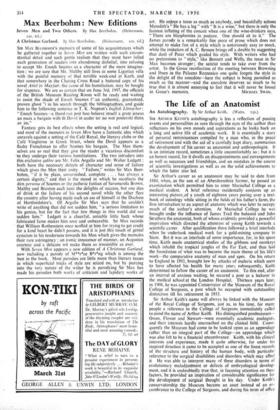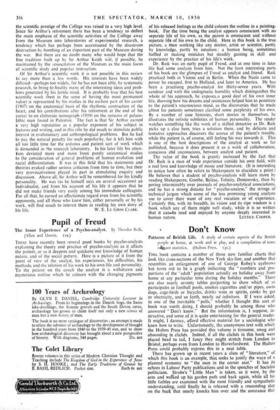The Life of an Anatomist
An Autobiography. By Sir Anhui. Keith. (Watts. 2 cS.) SIR ARTHUR KEITH'S autobiography is less a reflection of passing events and personalities as seen through the eyes of the author than reflections on his own moods and aspirations as he looks back on a long and active life of academic work. It is essentially a story of personal reminiscences compiled by a man Who, in the peace of retirement and with the aid of a carefully kept diary, summarises the development of his career as anatomist and anthropologist. It is an intimate record, sometimes a little uncomfortably so ; but it is an honest record, for it dwells on disappointments and estrangements as well as successes and friendships, and on mistakes in the course of scientific investigations as well as on the solid acliievements to which the latter also led.
Sir Arthur's career as an anatomist may be said to date from 1884, when, as the son of an Aberdeenshire farmer, he passed an examination which permitted him to enter Marischal College as a medical student. A brief reference incidentally conjures up an interesting picture of a youth of eighteen years poring over a text- book of osteology while sitting in the fields of his father's farm, the first introduction to an aspect of anatomy which was later to occupy much of the author's attention. At Marischal College he was brought under the influence of James Trail the botanist and John Struthers the anatomist, both of whom evidently provided a powerful inspiration which directed the attention of young Keith towards a scientific career. After qualification there followed a brief interlude when he undertook medical work for a gold-mining company in Siam. But it was an interlude of some importance, for, in his spare time, Keith made anatomical studies of the gibbons and monkeys which inhabit the tropical jungles of the Far East, and thus laid the foundation of what was to become the main theme of his life's work—the comparative anatomy of man and apes. On his return to England in 1892, brought low by attacks of malaria which seem to have affected his health for many years subsequently, Keith determined to follow the career of an anatomist. To this end, after an interval of anxious waiting, he secured a post as a leciurer in the medical school at the London Hospital. Thirteen years later, in 1908, he was appointed Conservator of the Museum of the Royal College of Surgeons, a post which he occupied with outstanding distinction till his retirement in 1933.
Sir Arthur Keith's name will always be linked with the Museum of the Royal College of Surgeons, just as, in his time, for many people a reference to the College of .Surgeons immediately called to mind the name of Arthur Keith. His distinguished predecessors— Owen, Flower and Stewart—were essentially academic zoologists, and their interests hardly encroached on the clinical field. Conse- quently the Museum had come to be looked upon as an appendage rather than an integral part of the College—an appendage which was also felt to be a financial encumbrance. Keith, with his clinical interests and experience, made it quite otherwise, for under his inspired direction it came to be accepted as one of the finest records of the structure and history of the human body, with particular reference to the surgical disabilities and disorders which may affect it. He was able to interpret many of these disorders in terms of evolutionary maladjustment or defects of embryological develop- ment, and it is undoubtedly true that, in focusing attention on these factors, he provided an 'inspiration of considerable significance for the development of surgical thought in his day. Under Keith's conservatorship the Museum became an asset instead of an en- cumbrance to the College of Surgeons, and during his term of office
the scientific prestige of the College was raised to a very high level. Since Sir Arthur's retirement there has been a tendency to deflect the main emphasis of the scientific activities of the College away from the Museum into laboratories of experimental research, a tendency which has perhaps been accentuated by the disastrous destruction by bombing of an important part of the Museum during the war. But there are no doubt many who would hope that the fine tradition built up by Sir Arthur Keith will, if possible, be maintained by the iesuscitation of the Museum as the main focus of scientific study and popular instruction.
Of Sir Arthur's scientific work it is not possible in this review to say more than a few words. His interests have been widely diffused—perhaps too widely, for he has not been able, by systematic research, to bring to finality many of the interesting ideas and prob- lems generated by his fertile mind. It is probably true that his best scientific work (best in the sense of having the most permanent value) is represented by his studies in the earliest part of his career (1907) on the anatomical basis of the rhythmic contraction of the heart, and his contributions after his retirement at the end of his career to an elaborate monograph (1939) on the remains of palaeo- lithic man found in Palestine. The fact is that Sir Arthur earned a very high reputation as a popular exponent of his subject in lectures and writing, and in this role he did much to stimulate public interest in evolutionary and anthropological problems. But he had to pay the natural penalty for such popularity, for it left him with all too little time for the arduous and patient sort of work which Is demanded in the research laboratory. In his later life his atten- kion deviated more and more from purely anatomical studies to the consideration of general problems of human evolution and racial differentiation. It was in this field that his statements and theories evoked rather serious criticism from time to time, but their very provocativeness played its part in stimulating enquiry and discussion. Above all, Sir Arthur will be remembered for his kindly personality. He was (as he .himself says on several occasions) an individualist, and from his account of his life it appears that he did not make friends very easily among his immediate colleagues. For all that, he earned an affectionate regard even from his scientific opponents, and all those who knew him, either personally or by his work, will find much to interest them in reading his own story of



































 Previous page
Previous page